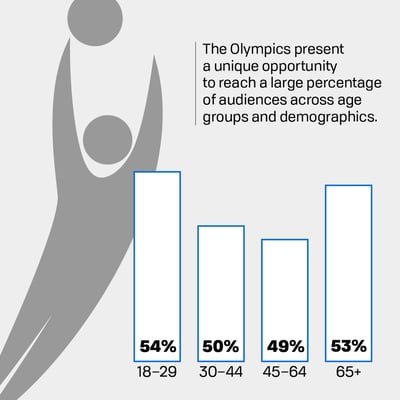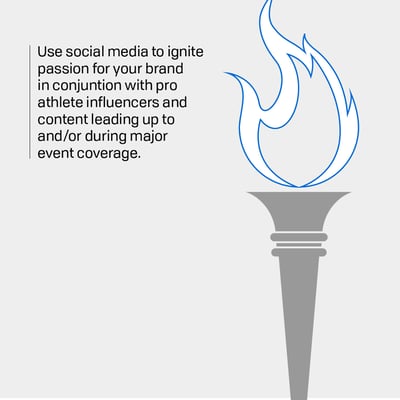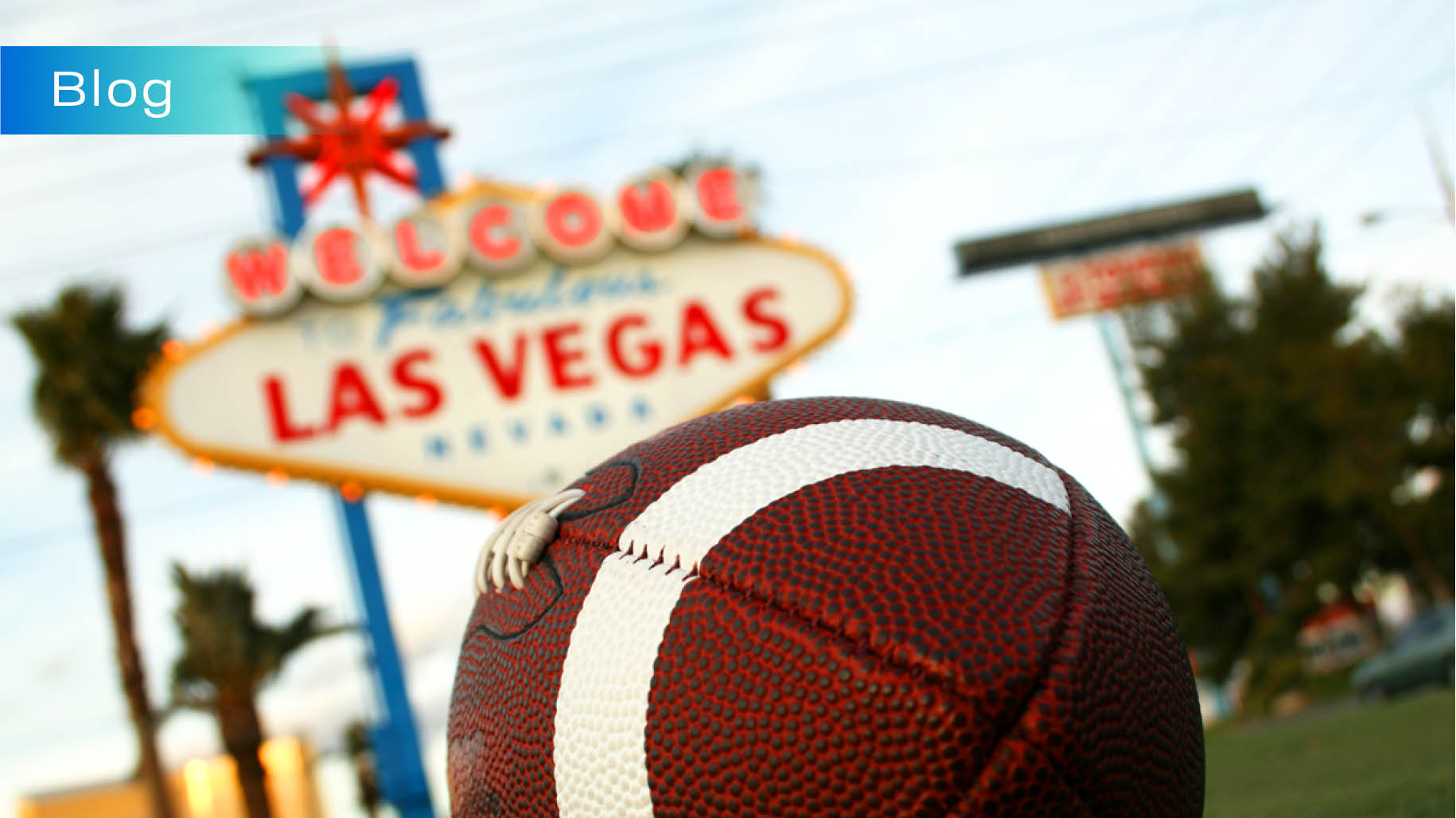The effectiveness of sports marketing (during the Olympics and otherwise) is undeniable, helping brands reach new heights. Brands can influence and resonate with a targeted sports-minded audience that is full of extreme passion and loyalty. Tapping into those emotions allows your business to be associated with those same intense feelings.
Take, for instance, LinkedIn’s example of Red Bull. According to their reports, Red Bull's success is a result of its sports marketing strategy, claiming that athletes and fans can harness the power of the energy drink (concentration, fast reactions, and endurance) during consumption. It also benefits the company that its values are aligned with many sports.
Marketing during the Olympics has been a teachable lesson for brands, extending reach into more extensive and engaged audiences. After all, Red Bull is an Australian company, and yet, it has made a significant mark here in the U.S. Below are helpful tips for advertising in and around the Olympics.
 Know Your Audience
Know Your Audience
Millions of people watch the Olympics worldwide, of all ages and interests. Statista reported that during the 2021 Summer Olympics in Tokyo alone, the share of adults expected to watch the games was 54% of 18- to 29-year-olds, 50% of 33- to 44-year-olds, 49% of 45- to 64-year-olds, and 53% of 65-year-olds and older.
Nowhere else is it possible to reach such a dynamic range of ages at the same time with your brand message, offering a unique and unforgettable opportunity. Some are casual watchers; some are die-hard sports fans. Nonetheless, you want to be inclusive of all.
This is where knowing your target audience becomes essential. Using the consumer data you've collected, you can segment audiences and deliver targeted TV ads that resonate with those audiences. Other targeted ad opportunities include display ads, banner ads, video, and native (fun fact: native is especially popular with Baby Boomers).
Advertising in the Olympics Requires Agility
All types of marketing—from sports marketing in football and baseball season to big events like the Olympics—require being nimble and pivoting when necessary. For this reason, you must always be ready to adapt.
An excellent example of the need for this marketing agility was when the pandemic hit unexpectedly, and the 2020 Tokyo Olympics was delayed as a result. Brands had no choice but to pivot during the uncertainty and adjust their Olympics advertising strategies to reach target audiences facing uncertain and abnormal circumstances—financially and in the world of sports in general.
Athletic brands, specifically, were forced to pivot their advertising in the Olympics. According to Footwear News, the most prevalent adjustment was to focus on athletes and their stories. Armed with a host of struggles and hurdles, advertisers had some rich storytelling opportunities to tap into and resonate with sports fans. The magazine highlights the brand Lacoste, specifically.
"It's obvious we had to adapt with the postponement, but it's the athletes [lives] in this unexpected situation that have been the most complicated," Catherine Spindler, the Chief Brand Officer of Lacoste, explained. "They have to prepare again, stay focused on that goal, that lifelong dream. The tenacity of the athletes is a strong value that we also have here at Lacoste."
Olympic Advertising: Get the Timing Right
Timing is everything in sports marketing, whether you're focusing on the full season or special live events. You must time the content right to ensure your content/ads are seen at the right time by the right people.
For instance, a brand selling swimming products will want to deliver its messages during the various swimming sports competitions over track or basketball competitions. The day of the week and timing (morning vs. midday vs. evening) is important, since the audience you reach will be more active and engaged in one timeframe than the other.
A surefire way to ensure you’re getting your marketing out at the right time is by scheduling content, ads, and even emails to correspond with sporting events. A good sports marketing strategy leads up to games/events to create a buzz and excitement among its audience. Come time for game day, you'll want to continue with that momentum by marketing during the event, when everyone is captive and watching.
 Partner with Influencers to Reach Gen Z and Millennials
Partner with Influencers to Reach Gen Z and Millennials
Integrating influencer marketing into your sports/Olympic marketing strategy is a great way to elicit more credibility and trust with your brand. Not only can you maximize your reach with younger generations and cord-cutters, but those audiences trust the opinions of their favorite influencers.
A 2019 Edelman Trust Barometer Special Report found that at least 63% of adults between 18 and 34 trust what an influencer says about a brand more than what it says about itself in advertising.
A common challenge with reaching Gen Z and Millennials is their reduced cable viewership. You can formulate a multi-channel advertising plan including influencers on social media to get over this hurdle, though.
Social Media In Sports Marketing
Great examples of campaigns that maximized their advertising potential during the Olympics by leveraging social media include Ford's "We Are All Fans" campaign (used TV and Snapchat ads), Oiselle (used the hashtag #TheBigEvent on social media platforms), and Previnex, an Olympic athlete sponsor (used Kristin Hildebrand to fill their Instagram with fascinating stories).
Another example of effectively using social media in sports marketing is NBC leveraging social media influencers to promote the 2016 Olympics. Called a GIF "torch relay," NBC Olympics enlisted NBC Universal networks to "pass the torch" from one network to another every 30 minutes before the opening ceremony. They also partnered with social influencers from various categories (Flula, The Fine Brothers, Jerry Purpdrank, Amanda Cerny, Charisma Star, Madison Pettis, and Tiffany Alvord) to deliver Olympics content. These tactics to use social media in sports marketing helped to successfully persuaded more people to tune in and can be used by a range of brands, influencers, niches, and budgets.
Sports Marketing with MNI Targeted Media
Another surefire way to ensure you reach the right audience with the right message is to partner with MNI. Crafting a unique and highly targeted sports marketing strategy takes an in-depth knowledge of a sports fanbase and how they relate to you and your brand. We can get your brand ahead of the competition and at the forefront of your audience.
About the Author
@Janine Pollack, MNI Integrated Marketing Director and self-appointed Storyteller in Chief, leads the brand's commitment to generating content that informs and inspires. Before MNI, Janine worked with Sports Illustrated for Kids and has written numerous sports Emmy profiles for the Sports Business Journal.


